For guys who are thinking of buying a Japanese kei truck, or kei van, one of the first questions that comes up is: “What is the best kei truck / van?”
This is not an easy question to answer. One guy will just say: “Suzuki is the best. End of story.” The next guy will say: “Daihatsu Hi-Jet all the way!” And then a third fellow will give his opinion; “Subaru Sambar with the supercharger RULES!!”
Hmmmm. The fact is that pretty well every Kei truck is basically a good vehicle. Some will have features that you prefer to have (or, maybe, features that you would prefer to be without), others will have features that you simply must have (like a dump body, for example).
In an ideal world you could test drive every single kei truck and you could then narrow down which ones are best for you. But this is not an ideal world. (Oh, no! I’m beginning to sound like my father. When I was a kid and came to him with my silly ideas and dreams, I would hate it when he said that. “This is not an ideal world, son.” I would hate it so much that I would, mentally, block my ears to what he would say after: “So you’ve got to find some workable work around. It’s got to be workably workable.” And he would smile. He liked to play with words. I would grind my teeth and go off in a huff. I did that for years.)
So when it comes to the problem of choosing the best kei truck to export directly from Japan, test driving as many kei trucks as you can is great, of course, but hearing and reading the opinions of other guys who have owned, or who have driven, various kei trucks (and kei vans) is definitely a wise move too.
Of course, I haven’t driven or owned all of them, just some of them, so what I’m writing for you here about kei trucks and kei vans is just my take on these machines as I have dealt with them and driven them.
(On our main site you can find some important general information on Kei trucks)
Kei Trucks Have Generations
The first thing that comes to my mind about kei trucks and kei vans is how good they all are. The whole concept of the Japanese Mini Truck (and Japanese Mini Van) is an excellent one and it has clearly stood the test of time. Almost all of these vehicles have gone through a number of generations by now (2019).
Take my favorite Subaru Sambar. It came out way back in 1961. All the first Sambars had a 360cc, two stroke engine. And you got only two cylinders. They were not the fastest things in the world, but, gosh, they were cute.
And, once in a while, you might get extra lucky and it would come with a cute girl, as in this old publicity photo.
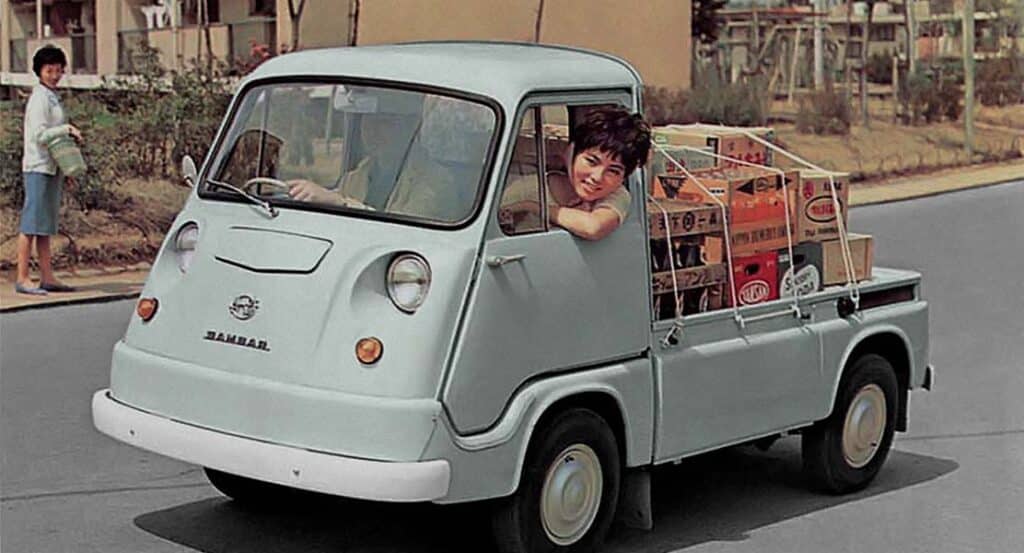
Later the Sambar got a bigger, 550cc, engine, this time a four stroke unit but still an inline twin.
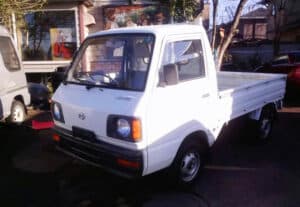
I’ve driven these fourth generation 550cc Sambar kei trucks and, although they are older now, they are good little mini trucks. Don’t be put off by thinking: “It’s only 550cc. It’s only two cylinders.” The fact is that these little old guys grunt, and their 4WD with “Extra Low” will pull you out of pretty well anything. (I’ll talk more about this feature later when I review a newer, fifth gen, Sambar.)
With the fifth generation and sixth generation, we are into thoroughly modern kei trucks with 660cc, four cylinder engines. And with a very effective super charger, if you want it.
The seventh and eighth generation Sambars are actually Daihastu Hi-Jet trucks. Tenth generation Hi-Jet in the case of the present Sambars. So you’ll see what I’m saying: these kei trucks have gone thought multiple generations: ten, and counting, in the case of the Daihastsu Hi-Jet. Looks like a pretty successful concept to me.
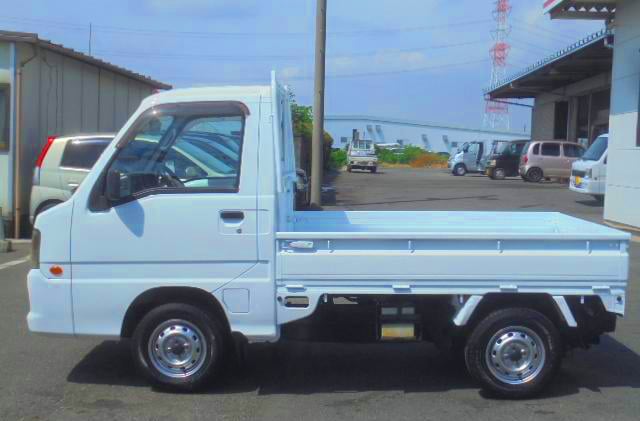
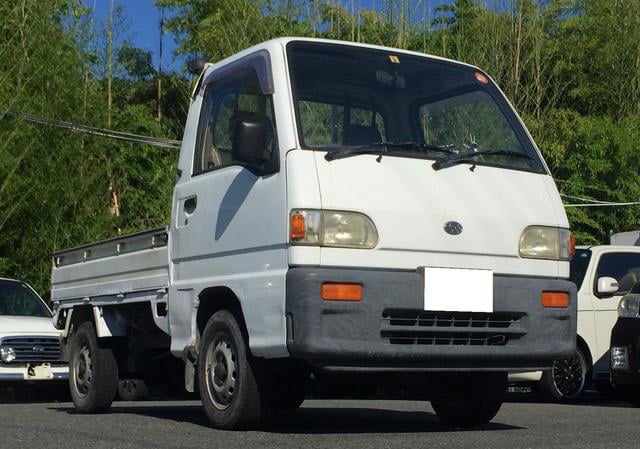
We have an overview of the generational differences that you’ll find with Japanese mini trucks on our main website here.
Kei Trucks I Have Driven
So let’s have a look at some of the kei trucks I have driven: A 2000 Suzuki Carry, a 1996 Daihatsu hi-Jet, a second generation Honda Acty, a third generation Acty, a 1987 Subaru Sambar, a 1994 Subaru Sambar, my own, and very loved, 1996 Subaru Sambar Diaz Van, and others.
You can import vehicles like these now from Japan to the USA, Canada, the UK, Australia (in the case of the 1987 550cc Sambar), and the European Union. We are always sourcing good units at good prices from the Japanese used car auctions and from the Japanese used car dealers that we work with here. Finding a good, clean 4WD kei truck in Japan is not a problem, and deciding which one you want is the fun part. I hope that what I have to say about the kei trucks that I have driven gives you something at least to get your teeth into as you start to look seriously at importing a kei truck yourself direct from Japan.
Please have a look at the spec comparison table to aid in your decision and contact a JCD agent for assistance.


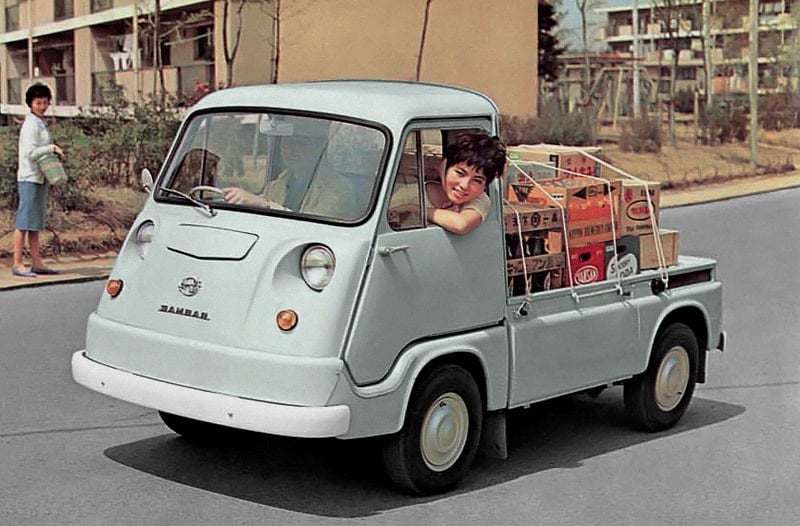
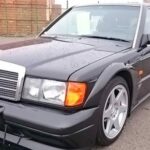
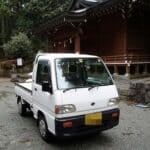



I love the picture of the fifth-generation truck and how the white truck has a nice open back to haul stuff, but the vehicle is still small overall. My boyfriend wants a truck but doesn’t want anything super big. I think he’d like to find Japanese mini trucks for sale similar to this.
Hi Sabrina,
Thank you for your comment!
Mini trucks are are definitely small but can haul around 800 pounds and with 4WD and rear diff lock go anywhere!
To get more info and explore the possibility of importing, please come and register: /auction-registration/
We look forward to taking the best care of you humanly possible!
Scott
JCD General Manager
I would not place much faith in the technical expertise of this writer. He still believes that one needs to warm up an engine by letting it sit at idle a long time before driving off ! That is not good for engine life or keeping the air pollution of your environment to a minimal level . A modern engine has fuel control electronically controlled & the longer your engine stays cold , the more fuel it will use. During the time it stays in Cold Enrichment mode , there is excess fuel delivered & it will cause the oil on the cylinder surfaces to be washed off & thus increase wear of both the piston & cylinder as a result of the oil being washed away by the excess fuel delivery. It is most wise to wait about 15 – 20 secnds only so that full oil pressure is delivered into the engine bearings. Once that has been done You should immediately drive at a regular rate , never rev an engine needlessly without any load placed upon it. The power you develop has no where to go & accelerates the wear of the engine greatly. If you notice the temperature gauge of the engine , you will notice that it takes only one or two minutes at normal city cruising speed to get the engine fully warmed up. It is also good that you get engine warmed up that quick if you yourself are cold & then can use the warmed up engines excess heat to warm you inside the cab instead of just wasting the heat outside as is the usual direction of excess engine heat. If you wish engine to last , Just wait the 2 minutes of driving as you pull away & then turn on the heater AFTER the engine has been warmed up in that 1st 2 minutes of Mature type driving ! Never be a stupid kid reving up the engiv=ne needlessly I am the top smog tech in California , U.S. & I advise you to be wise. Don’t pollute by wasting time letting a cold engine idle & waste fuel. Nick , NavyBlueSmoke , LST-1195
Good points and advice here from Nick for those of us who want to keep our ride for a long time. Modern electronic fuel injected engines don’t need anywhere near the warm up time of the old manual choke machines or, heaven help us, the old automatic choke carbs. (Horrible, stinky old things they were!) And, unless you are buying an antique Japanese Minitruck from us here, the used Kei trucks that we export from Japan now are non-choke carbs or fuel injected (EFI) units.
How long should we warm up and how soon after starting a cold engine should we get underway? These are important issues for extended engine life, especially when, as far as I know, most engine wear occurs in the first six seconds of operation after we start our cold engine after it’s been sitting all night. Over the night, some oil has dripped down off the cylinder walls and off some bearings, too, so when we first start, and before the oil pressure goes up, there’s this little window of reduced oil protection (although modern oils with their advanced additives are so much better in this area that the “old stuff”).
Yep, as Nick says, definitely wait those precious 15-20 seconds for the oil pressure to come up, and don’t dash off revving a cold engine and carrying a heavy load of fertilizer like my old father-in-law did far too often.
I don’t advocate excessively long warm up times, but, as with most things in engineering, it’s application specific. I consider the age and condition of the engine, the outside air temperature, and how loaded the truck is. Cold morning? I’ll give my ride a bit more warm up time. Got a load on or facing an immediate climb up hill?….yeah, I’m gonna give him some more seconds. If he’s a real high mileage car, like some of the cars I’ve driven? I’ll let the old goat get a bit warmer so that he’s running stable and smooth and I’m not stressing him too much or spewing out improperly burned fuel. But, yeah, senselessly long warm ups just end up stressing the engine and the eco system.
To me it’s a question of balance: Driving down the road, a cold engine will use a bit more fuel than a warm motor (and will produce more emissions), but idling too long is just using fuel, putting out CO2, CO, and N2 and not getting me anywhere. And, as Nick points out, revving an engine without a load on it is not doing our machine any favors. Prolonged idling is classed as severe service. I was sure surprised when I first drove that Honda ACTY: A light touch on the pedal and up he revved….and, no, that’s now my normal style of driving. Excessive revving certainly stinks up the planet and will send our motor in to the rebuilder pretty quick.
Another good point, too, from Nick for longer engine life: if we let our engine warm up first before we ask it to heat up the cab, it makes the whole engine warm up cycle that much quicker and cleaner. (And like the father in Calvin and Hobbs says: It will help us to build character )
I love the idea of Kei Truck Troops!!! What a cool thing to do in retirement. 🙂
Hey Jared! Check your email and lets get after your first truck today!
Hey there! I’ve been reading your blog for a while now and finally got the courage to go ahead and give you a shout out from Huffman Texas! Just wanted to say keep up the fantastic job!
Hello,
We are a Japanes truck body build company. We will be releasing Kei-truck hatchback coope very soon.I am wondering if you are interested our Kei-trucks for your market in Australia and Unitedstate.
Please visit our web page at: https://www.truck-body.jp/
Thank you.
Satoshi Tsubakidanai
KYORITSU Industly Co., Ltd.
Hello Satoshi,
Thank you for contacting us.
Our main Kei truck market is the US. Do you have any garages nearer to the export yards?
Please contact me on whatsapp +81 80 7972 1982
Kind Regards,